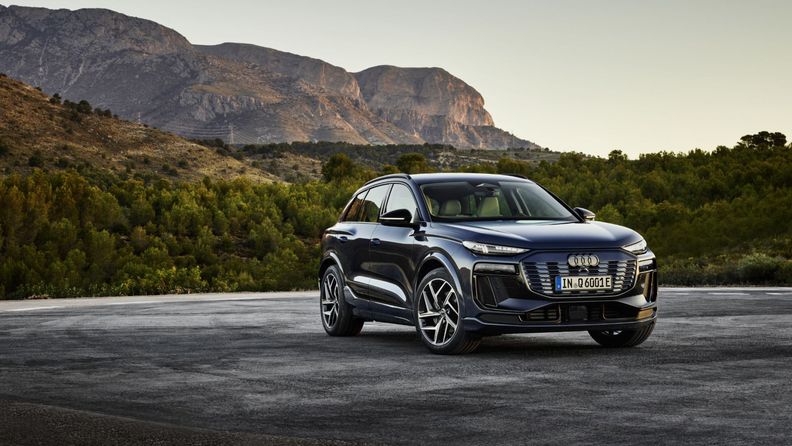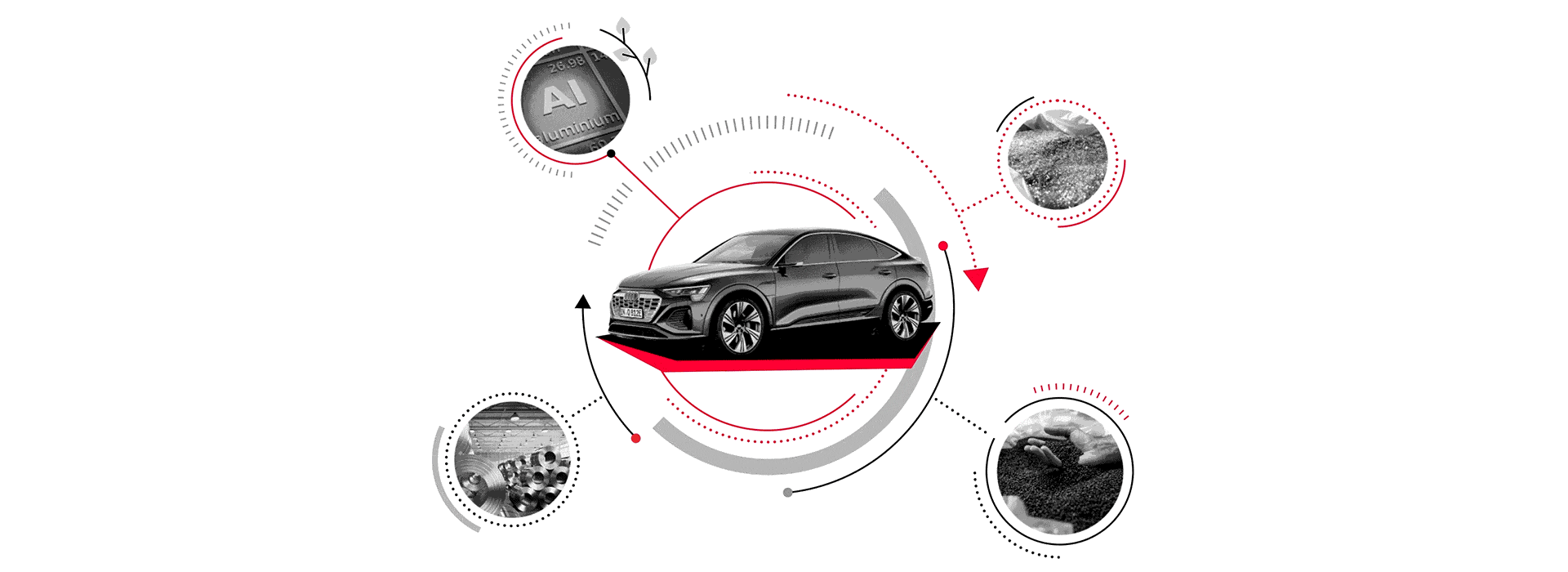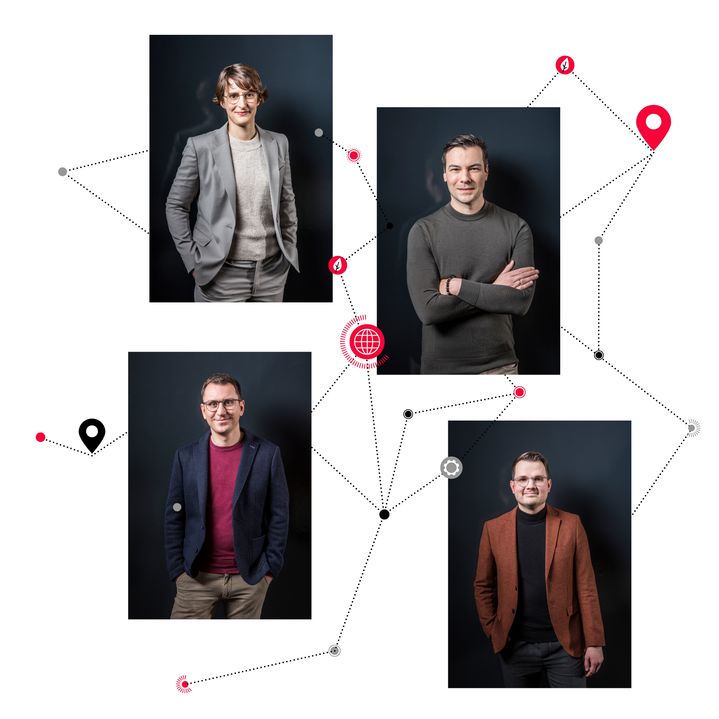Less is more
Audi regards net carbon neutrality as a state in which, following the exhaustion of other possible measures aimed at reducing the still remaining CO₂ emissions caused by the products or activities of Audi and/or currently unavoidable CO₂ emissions within the scope of the supply chain, manufacturing and recycling of Audi vehicles, at least quantitative compensation is provided through voluntary and globally conducted compensation projects. Throughout the utilization phase of a vehicle, meaning from when a vehicle is delivered to a customer, CO₂ emissions produced are not taken into account.
Audi regards net carbon neutrality as a state in which, following the exhaustion of other possible measures aimed at reducing the still remaining CO₂ emissions caused by the products or activities of Audi and/or currently unavoidable CO₂ emissions within the scope of the supply chain, manufacturing and recycling of Audi vehicles, at least quantitative compensation is provided through voluntary and globally conducted compensation projects. Throughout the utilization phase of a vehicle, meaning from when a vehicle is delivered to a customer, CO₂ emissions produced are not taken into account.
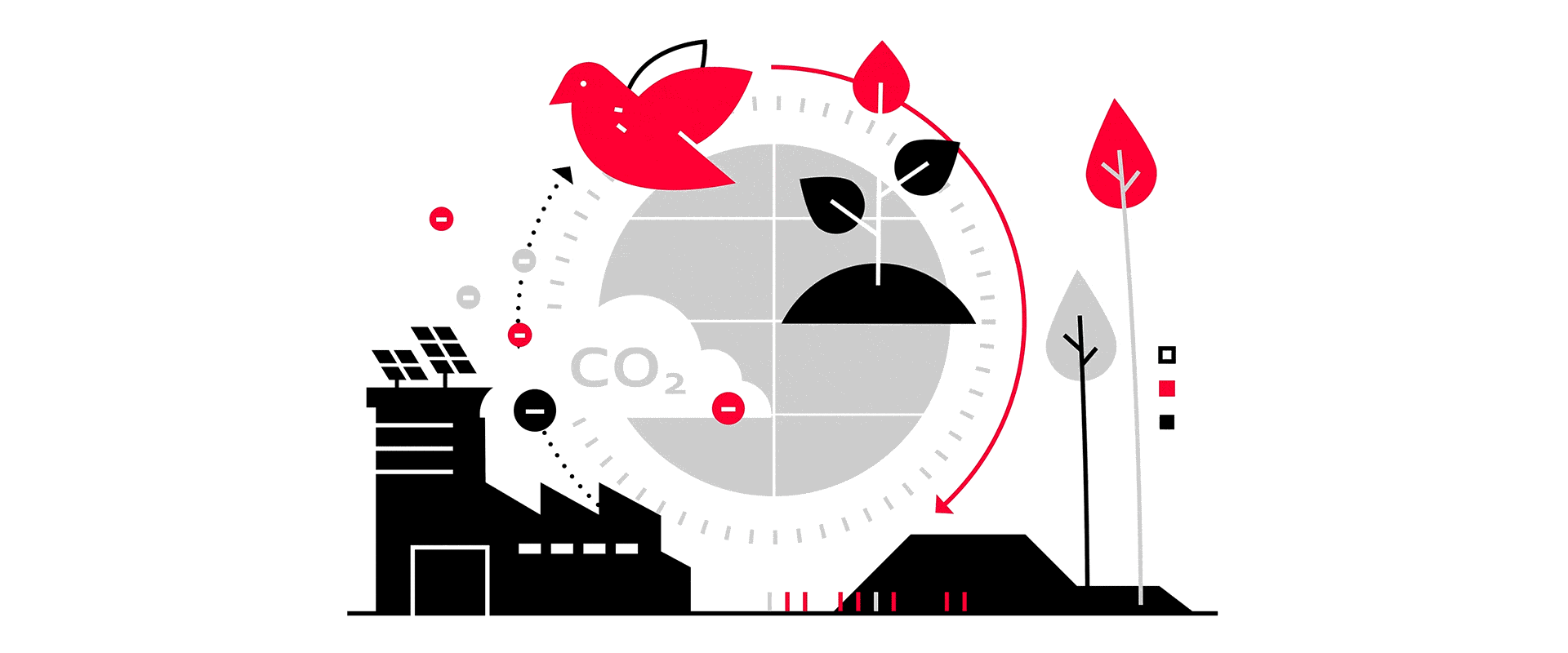
Audi is committed to the Paris Climate Agreement and its goals. The company is aware of its responsibility in ensuring a sustainable future. Numerous measures along the value chain contribute to the goal of achieving net carbon neutrality 1 as a company by 2050. One focus is the decarbonization of production and logistics in order to achieve the target of carbon neutrality 1 at Audi production sites by 2025.
“Audi is taking a strategic approach and has consolidated all environmental protection activities in production and logistics in the Mission:Zero environmental program,” explains Achim Diehlmann, Head of Environmental Protection at the Neckarsulm site and the Mission:Zero project manager. “Our focus is on the four action areas of decarbonization in production and logistics, water usage, resource efficiency and biodiversity.” The guiding principles are the United Nations Sustainable Development Goals (SDGs) and the Volkswagen Group’s environmental mission statement.
Mission:Zero – Decarbonization
The year 2022 was a challenging year for the global Mission:Zero team led by Achim Diehlmann and especially for the experts in the “Decarbonization” action area. Markus Faigl, Head of the “Decarbonization of sites” action area: “The war in Ukraine is also impacting our work. It was a new experience for us to face the question of whether we would actually be supplied with gas. In response to this energy crisis, we developed contingency plans and had to revise our existing energy supply concepts.”
Since the launch of Mission:Zero, it has been the clear aim of Audi to not only cut its energy consumption but also reduce its dependence by generating its own renewable energy. The challenge now is the new demand being made on the speed at which this transition is taking place. Markus Faigl: “The energy crisis in 2022 has accelerated this process. We want to move faster to achieve greater energy independence and become more resilient as a result.” Rising energy prices have also increased the pressure on the company to act and step up the pace of progress along its chosen path. Every kilowatt hour of energy it produces itself at lower cost does not have to be purchased expensively.

The goal is for all Audi sites 2 to be net carbon-neutral 1 by 2025. This includes CO₂ emissions generated directly at the site (Scope 1) 3 and indirect CO₂ emissions from energy procured through external suppliers (Scope 2). 4 The reported figures in the diagram establish the amount of CO₂ emissions already saved at the sites by using renewable and low CO₂ energy sources in relation to theoretical maximum CO₂ emissions based on an energy supply that relies solely on fossil energy sources.
Energy intensity of the Audi Group – Automotive segment5 in MWh/vehicle

A variety of carefully thought-out energy-saving measures – such as reducing the room temperature in offices and halls coupled with a mild winter – led to considerably lower energy consumption: the energy intensity of the Group relating to automotive production including component manufacturing was 2.74 MWh per vehicle 5 (MWh/vehicle) in the year under review. That is 12.74 percent (0.4 MWh/vehicle) less than in 2021.
Energy consumption within the Audi Group total/by type6 in MWh

Total energy consumption within the Group (in MWh) actually went down a little – despite the fact that the Audi Group produced over 100,000 vehicles more in 2022. The share of energy from renewable sources increased year-on-year by around 5.89 percent to 69.01 percent.

Total CO₂ emissions per vehicle produced in the year under review (in kg) also fell considerably. The intensity quotient – the intensity of greenhouse gas emissions related to automotive production including component manufacture – amounted to 203.73 kg CO₂ per vehicle in the year under review.
Markus Faigl and his team see this as an opportunity: “The current situation has been a catalyst for increasing the amount of renewable energy we produce ourselves and procure from nearby suppliers. Throughout the past year, we have been screening technologies in order to select optimal measures for our own production of renewable electricity and heat.”
The result: in the medium term, the company will significantly increase its own production of renewable electricity and heat and its procurement from nearby suppliers – for example, by installing photovoltaic systems and using heat pumps to recover the waste heat from production processes. The company also wants to switch to green electricity for a large share of processes that have previously relied on fossil fuels. “What we mustn’t forget, however, is efficiency,” says Markus Faigl. The rule still is: “Each kilowatt hour we save does not need to be produced or procured. We can achieve this, for example, by using more LED bulbs at our sites or by retrofitting ventilation systems with more energy-efficient motors.”
Carolin Fichtner is the Mission:Zero team expert on emissions in the logistics chain. “In 2022, we were successful in shifting more from road to rail,” explains the Head of the “Decarbonization in logistics” action area. One measure stands out in particular: the switch in cell module transportation to the Audi plant in Brussels, which is now to take place as a rule by rail and no longer by road. This has cut CO₂ emissions by just under 3,800 metric tons 8 each year. “Optimized transportation concepts and alternative technologies promise to yield substantial reductions in CO₂ emissions. For this reason, top of the agenda for 2023 is working with Volkswagen Group Logistics to develop a long-term roadmap for organizing the most climate-friendly transportation to and from our plants and to choose appropriate transport technologies – for example, biogas or electric trucks. We are also seeking to anchor our sustainable logistics requirements in our vehicle projects to ensure a focus on low emissions in the logistics chain at the early stage of planning.”
Mission:Zero – water
The careful use of this resource is a key aspect of Mission:Zero and the company’s environmental policy,” says Daniel König, Head of the “Water Usage” action area. Audi aims to use water sparingly and efficiently. By 2035, the Four Rings plans to roughly halve its ecologically weighted water consumption9 at its sites in Ingolstadt, Neckarsulm, Győr, San José Chiapa and Brussels. “This is an ambitious target and a major contribution toward greater sustainability for the company,” explains Daniel König. The vision for the future? “In the long term, we also want to be independent when it comes to water.”
Audi is pursuing a hotspot-based approach to water consumption and will first tackle those sites where availability is critical or consumption is particularly high. The company has defined four measures for the conscious and sparing use of water.
First: more efficient processes and state-of-the-art water-saving technologies, for example in paint shops and in various galvanizing baths or adapted leak testing processes during assembly.
Second: closed water cycles in which the water is treated and reused multiple times within the plant.
Third: increased use of rainwater.
And fourth: no use of drinking water in production.
Fresh water consumption in the Audi Group in m³ and in m³/vehicle
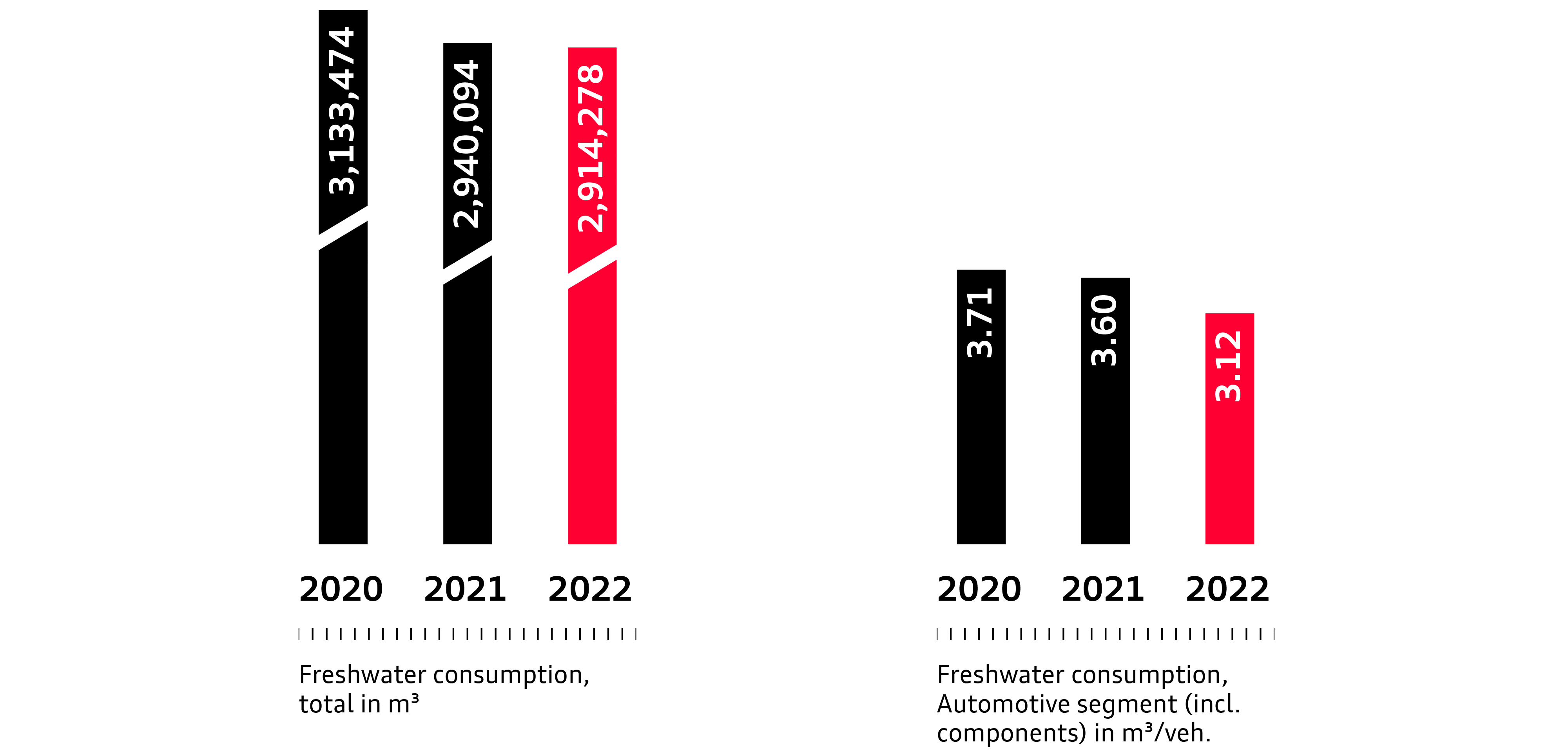
Careful use of resources such as water is a key component of the Audi environmental program Mission:Zero. In 2022, the Audi Group succeeded in reducing its water consumption significantly compared with the previous year – calculated in m³ per vehicle produced in the year under review and also in total. There are various reasons for this: as well as technical solutions (optimization of filter backwashing cycles during water pretreatment) and weather-related reasons (reduction in cooling requirements), the repair of leakages was also responsible for this decrease.
Total volume of wastewater discharge in m³/vehicle

The volume of wastewater, measured in m³ per vehicle, decreased in 2022. In absolute terms, however, the volume increased because 2022 was the first year in which the figures for Bentley (approximately 94,000 m³) were also added. In summary: the number of vehicles produced (Premium brand group) was up by around 15 percent over the previous year, but wastewater discharge only rose by around 7 percent.
For example, in 2022, Audi agreed with its Belgian partner Hydria to integrate the Brussels South wastewater treatment plant into the water supply for production operations at its Brussels plant. The aim is a successive transition until probably the end of 2024 until drinking water is no longer used in vehicle production. This should save around 100,000 cubic meters of drinking water each year.
As of 2025, the Audi plant in Neckarsulm aims to obtain its process water entirely from the effluent of the neighboring wastewater treatment facility, which is also where the site discharges its wastewater. The resulting water cycle will reduce fresh water consumption by more than 70 percent. The Audi México site in San José Chiapa is the first plant of a premium car manufacturer in the world to produce its cars completely without wastewater. In order to minimize its water consumption, Audi in Mexico is also relying on a large on-site rainwater reservoir with a capacity of around 234,000 cubic meters.
Moreover, in January 2023, Audi was the first premium car manufacturer to become a member of the Alliance for Water Stewardship (AWS). This global network of companies, NGOs and public-sector bodies is committed to the responsible use of water resources across the value chain. Through this membership, the Audi San José Chiapa site in Mexico can apply for certification according to the International Water Stewardship Standard, also known as the AWS Standard.
The aim of the AWS Standard is for water to be used as efficiently as possible (water management), while taking into account all relevant stakeholders in the relevant catchment area (water stewardship). To achieve this, the AWS focuses on a concept that goes beyond pure water management and covers five aspects: Good Water Governance, Sustainable Water Balance, Good Water Quality Status, Important Water-Related Areas, and Safe Water, Sanitation, and Hygiene for All. During certification, water management is appropriately assessed at both the site and catchment levels. For instance, the following questions must be answered: Where is there scope for reducing water consumption? Where can water pollution be prevented? And how can Audi ensure that other parties, such as local farms, do not suffer any disadvantages? “Our membership of the AWS is an important step for us because it also indicates to the outside world that we have aligned with its guidelines,” explains Daniel König.
Mission:Zero – resource efficiency
Natural resources are important production factors and a basis for industrial added value. However, resources are limited. The goal is not to use raw materials faster than they can be replaced by nature and its ecosystems, thus ensuring sustainable renewal. “At Audi, we want to use resources even more effectively and efficiently than we have in the past. To this end, we are continuing to develop our skills and approaches so that we ultimately use less,” explains László Horváth, Head of the “Resource Efficiency” action area.
Resource efficiency starts with the correct use of materials throughout the production process and ends with material recycling as late as possible. László Horváth: “Our goal is to feed materials into cycles because that saves resources and energy that would otherwise be needed to produce new raw materials.” Wherever technically and economically feasible, closed loops are thus to become an integral part of the automotive value chain at Audi.
The target for this action area is to reduce the amount of waste per vehicle within the plant by 10 percent by 2025 (base year: 2019) and increase the proportion of material recycled by 10 percentage points (base year: 2019). Other than that, reducing disposable waste remains the top priority. The goal is to decrease the volume by 35 percent compared with the base year 2010. According to László Horváth, three aspects in particular help to achieve these targets.
Total weight of waste by disposal method in t
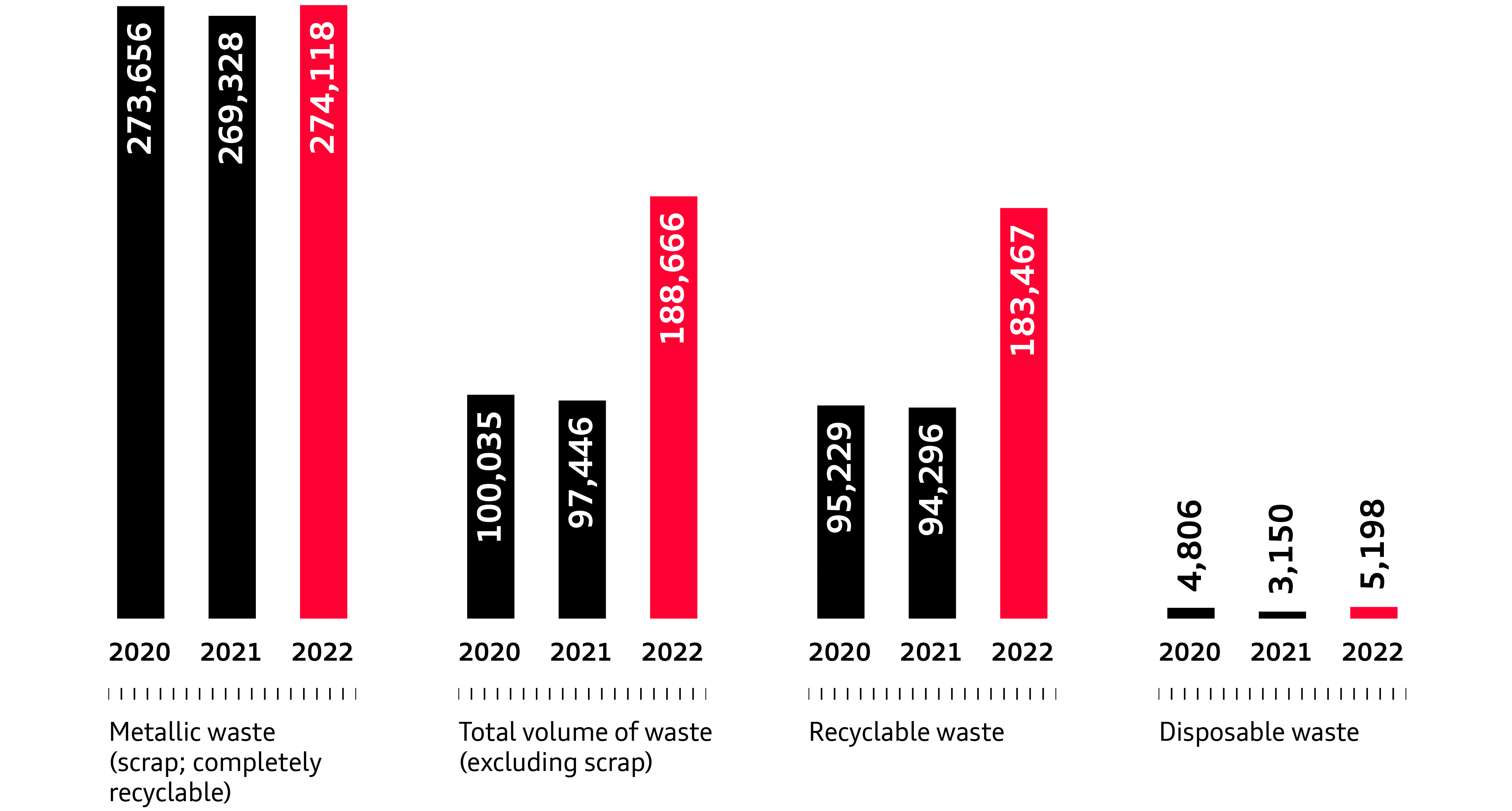
Wherever possible, Audi closes material cycles in order to reduce waste. In the year under review, 274,118 metric tons of metallic waste were generated throughout the Group, all of which is destined for recycling.
The volume of waste excluding metallic waste (scrap) was up, primarily due to optimized data collection: waste from construction work at the Neckarsulm site was included in this category for the first time in 2022. Approximately 90,000 metric tons of excavated soil from a construction project increased the total volume of waste to 188,666 metric tons, of which 97.24 percent is recyclable. Construction activity also explains the increase in the category of disposable waste.
No major discharges of chemicals, oils or wastes to the environment occurred during the reporting period.
First: close collaboration. “In the past, each Audi production site developed its own solutions for reducing waste without networking with other sites. Mission:Zero has changed that. We now work together and share our best practices.”
Second: material flow analyses, which are detailed input/output analyses. “These help to identify the greatest potential and produce a ‘Go to Zero’ checklist which we then work through successively,” explains Horváth.
Third: data-driven environmental protection using digital tools. “Our CO₂ calculator, which is currently being tested at several sites, will help our colleagues in Logistics and Procurement to take the right decisions on packaging materials.”
As much as necessary, as little as possible!
When it comes to packaging, we have been applying the principle of as much as necessary, as little as possible since 2022. Thanks to a large number of optimization measures in conjunction with suppliers, the team responsible for resource efficiency in the supply chain reduced plastic waste by just under 550 metric tons2 in the year under review. This won the project the “Zero Impact Factory Award” from the Volkswagen Group. Project manager Lutz Roth is satisfied: “This award in the Group and above all our results show that we are on the right course.”
Carolin Rauch from Supply Chain Development is familiar with the challenges involved with reducing packaging waste. “Packaging is a major issue for us as logistics specialists. On the one hand, we need to reduce packaging but it’s also a question of using renewable raw materials. Our goal is to use more than 90 percent recyclable packaging in new vehicle projects by 2030,” explains Rauch.
Mission:Zero – biodiversity
What does it take to successfully advance biodiversity? Antje Arnold, Head of the “Biodiversity” action area, is certain: “Ambitious goals. Because you can’t achieve ambitious goals if you don’t set them – and would fall far short of what could actually be achieved.” Thanks to this philosophy and a lot of persistence, Antje Arnold can look back at 2022 with satisfaction and forward to 2023 with anticipation. One thing is especially important to the success of the project: raising awareness.
“Raising awareness means ensuring that we all understand that our planet’s biodiversity is the basis for human life and that we must commit to preserving and reinstating it,” explains Antje Arnold. “To be honest, we’re at the same place now with this issue as we were with climate change 15 years ago. Back then, only few people were concerned about climate change – today, we can all feel the effects in our everyday lives.” For this reason, Antje Arnold and her colleagues are trying to generate enthusiasm for the issue – at the plant and beyond. Alongside local biodiversity projects that include renaturalizing open spaces at all sites and greater networking of the company with NGOs, governments and the immediately neighboring communities, the biodiversity index is a particular help.
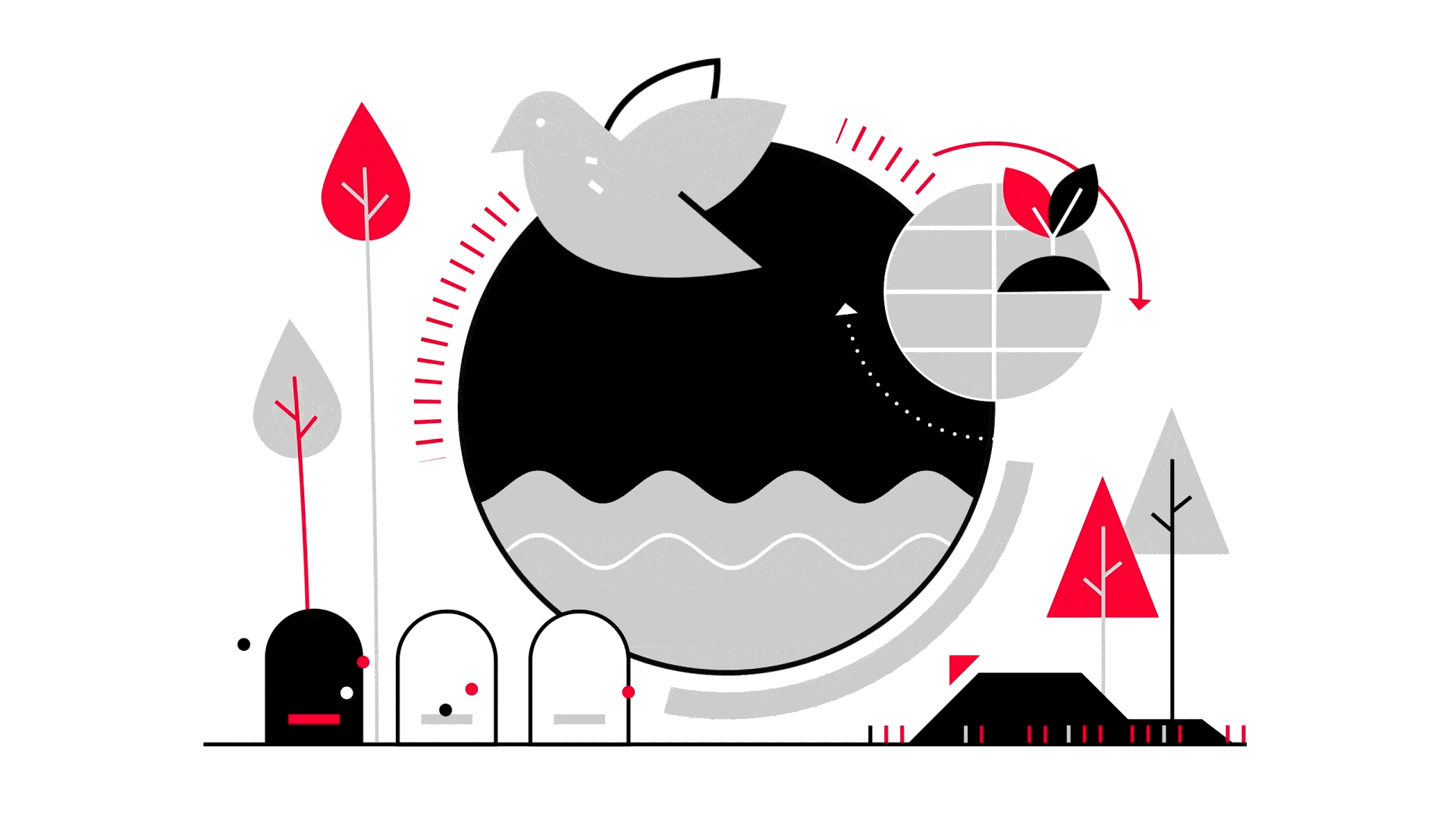
This index was a joint development with Volkswagen and records 58 biodiversity parameters for five Audi production sites.2 Factors include the degree of ground sealing at a site, the number of native plant species found at a site, campaigns to raise employee awareness and external conservation projects. Antje Arnold explains: “Projects undertaken in collaboration with external conservation initiatives are an important factor of the index. They enable us to extend our sphere of activity beyond the factory limits, raise awareness of us as a brand and boost our image.” For example, Audi employees were able to work with the regional bird protection society to maintain renaturalized spaces outside the factory fence.
The advantage of the index is that it makes it easier to track progress, sites are comparable and the effectiveness of individual measures is quantifiable. Of course, this index is also coupled with an ambitious goal. Arnold: “By 2025, we want to increase our index by 50 percentage points, achieving an average of half of the biodiversity index across all Audi plants.”
Environmental management at Audi
Audi carefully analyzes environmental aspects in its worldwide manufacturing network – with the vision of building its cars in net carbon-neutral plants1 by 2025. Along with CO₂ emissions, Audi looks at all other site-based environmental aspects of operational value creation.
The basis of environmentally compatible production at Audi is the environmental and energy management systems that the company has gradually introduced since 1995. The environmental management system of the European Union, EMAS (Eco-Management and Audit Scheme), is installed at almost all European car plants of the Audi Group.
The Audi production sites in Germany and abroad have management systems accredited according to DIN EN ISO 1400110 or DIN EN ISO 5000111. The European sites, in particular, are validated additionally in accordance with the EMAS, the premium standard of the European Union.
It requires that the sites in question demonstrate the sustained improvement of their environmental performance to specially accredited environmental experts. Compliance with legal requirements is the starting point for this. The Chairman of the Board of Management defines the environmental and energy policy, which is binding for the entire company. Its requirements are reviewed periodically and amended as necessary.
The environmental and energy policy applies to all products, services and activities, and is implemented at all levels of the company. The Environmental Protection organizational unit coordinates the Audi Group’s activities in the area of ecology and is the main point of contact for the respective environmental protection bodies of the Volkswagen Group. It develops overarching and strategic regulations and implements these in practice. Environmental protection at the sites comes under the responsibility of the respective environmental protection officer.
Scope of the key figures
Unless otherwise indicated, the environmental key figures are determined on the basis of Volkswagen standard 98000. This standard defines how operational environmental data is to be determined within the Volkswagen Group and its subsidiaries.
The aim is to collect and document all environmentally relevant data from all the plants in a comparable manner. The environmental data is primarily based on measurements and calculations.
The figures may contain estimates if, for example, they are based on statements from energy suppliers that were not available when data was collected. If significant deviations between the actual values and the reported data are identified in the following year, the data is updated.
The individual key figures for 2021 were updated in this report using the actual values for 2021.
The scope of the environmental key figures relates to the production sites of the Audi Group. Unless otherwise indicated, these are the following plants: Ingolstadt, Münchsmünster, Neckarsulm, Brussels, Győr, San José Chiapa, Crewe (Bentley; since 2022), Sant’Agata Bolognese (Lamborghini), Bologna (Ducati), Amphur Pluakdaeng (Ducati). Only car-producing sites including component manufacturing are considered for the specific key figures.
In addition to the environmental data of the Audi Group (including Ducati motorcycle production at Bologna and Amphur Pluakdaeng), the environmental data for car production (Ingolstadt, Münchsmünster, Neckarsulm, Brussels, Győr, San José Chiapa, Crewe (since 2022) and Sant’Agata Bolognese sites) including San Jose Chiapa) is also shown separately for better comprehensibility.
Audi worldwide
Models, products and services – switch to your country / sales region website and discover the regional diversity of Audi.
